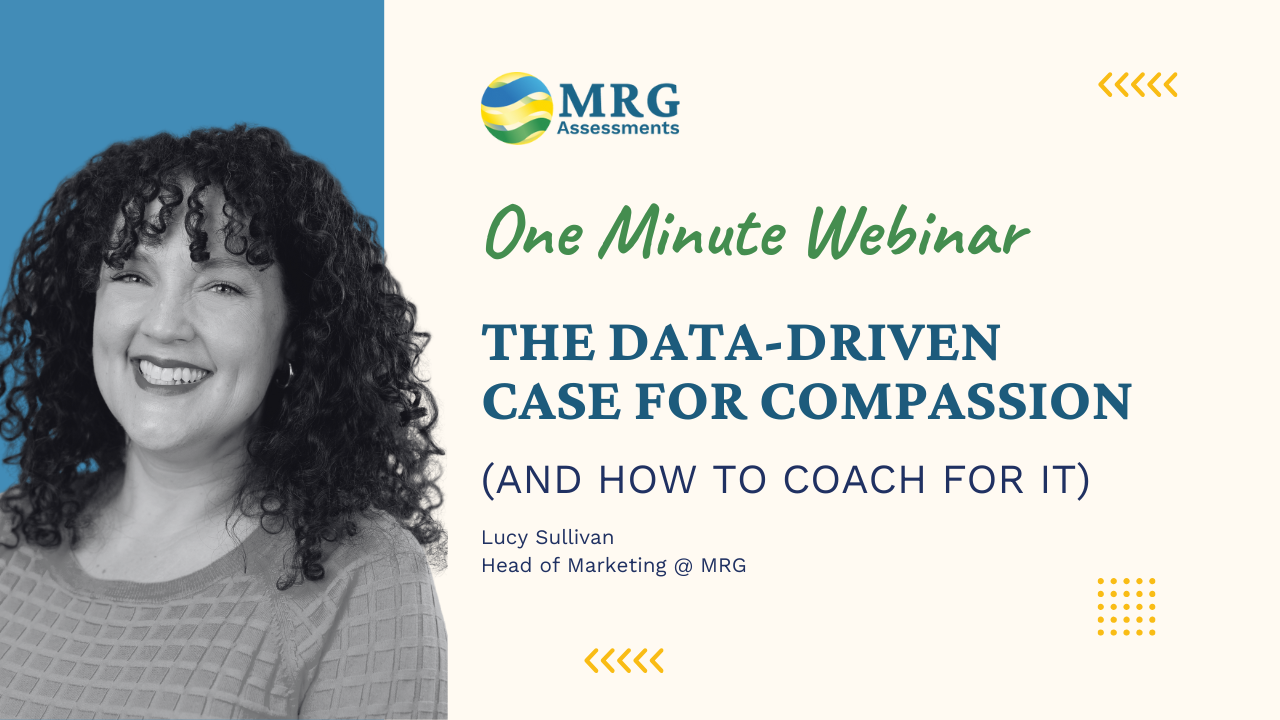Coaching for Compassion (and the Data-Driven Case For It)

In today’s high-pressure business environment, “compassion” might sound like a soft skill. But at MRG Assessments, our research proves the opposite: compassionate leaders consistently outperform those who don’t lead with empathy, engagement and awareness. Our one-minute webinar “The Data-Driven Case for Compassion (and How to Coach for It)” highlights this insight — showing how coaching for compassion is no longer optional but essential for leadership impact.
What Does Compassionate Leadership Look Like?
Compassionate leadership isn’t about creating a “nice” culture or lowering standards—it’s about understanding others, connecting purpose to practice, and adapting behavior to fit human and business needs. The companion article “How Do Compassionate Leaders Get Big Results Without Setting Big Goals?” reinforces this: compassion + clarity = performance.
At its core, coaching for compassion means:
- Noticing people’s needs, motivations and context
- Responding with clarity, authenticity and aligned action
- Adapting leadership behavior based on insight rather than habit
Why Coaching for Compassion Drives Performance
In the webinar, MRG’s research on nearly 6,000 leaders showed what many assume: high-compassion leaders rated higher on 30+ leadership competencies than low-compassion peers.
From this data we learn:
- Compassionate leaders engender trust and psychological safety, which correlate strongly with innovation and agility
- When leaders coach for compassion, they reduce derailments, improve retention, and strengthen culture — key business outcomes
- Coaching for compassion scales beyond individual skill — it becomes a system of leadership development that aligns with strategy and culture
Four Focus Areas for Effective Coaching for Compassion
Here’s how coaches and organizations can operationalize compassion into leadership development:
Develop self-awareness of impact
Before compassionate behavior can emerge, leaders must understand how their actions are viewed. Coaching for compassion uses assessments like Leadership Effectiveness Analysis™ (LEA) and Individual Directions Inventory™ (IDI) to reveal gaps between intent and impact. Leaders learn: “I intend to support, but others perceive exclusion.”
Amplify relational behaviors
Compassionate leadership shows up in how a leader connects, listens and responds. Coaching helps leaders practice storytelling, influence, active listening and relational presence. These behaviors, when coached intentionally, strengthen a leader’s ability to engage and empower others.
Embed behavioral systems
Compassion isn’t a one-off—it’s a habit. Coaching for compassion focuses on systems: peer-coaching circles, feedback loops, behavioral trackers, role-play and follow-through. These ensure compassion becomes part of the leadership fabric rather than a fleeting moment.
Link to business performance
It’s critical that compassionate leadership moves beyond feel-good to measurable value. Coaches track indicators such as: improved team engagement scores, reduced turnover, stronger leadership pipeline readiness, and enhanced adaptability in change contexts. the phrase “coaching for compassion” means bridging human-centered leadership with business outcomes.
How MRG Supports Coaching for Compassion
MRG’s globally validated research-based assessments and coaching frameworks support this approach:
- LEA unveils leadership behavior patterns and how they align with or diverge from compassionate leadership standards.
- IDI uncovers a leader’s underlying motivators—so coaches understand why certain relational behaviors succeed or struggle.
Together they give coaches and organizations the data, language and structure to build tailored interventions for compassion-driven leadership.
Practical Steps to Get Started
- Begin with a short diagnostic: Which leaders are rated high on relational influence but low on perceived empathy?
- Use assessment feedback to identify “compassion gaps” (e.g., strong task orientation but low empathy).
- Design coaching modules that focus on relational behavior experiments (e.g., “listen first, then respond” over two weeks).
- Set follow-up metrics: Did team members report higher psychological safety? Has there been fewer conflicts or misunderstandings?
- Scale the model: Consider peer coaching groups, leadership forums, and organizational routines that reinforce compassionate behavior across teams.
Final Thought
Coaching for compassion isn’t a soft alternative to leadership—it’s a strategic imperative. In a world of disruption and complexity, leaders who listen, respond and align with people get results. The data is clear. Now, the question is: Are you coaching for compassion, or leaving it to chance?